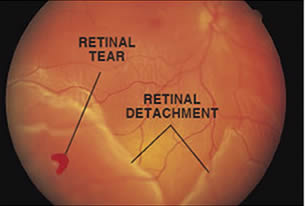What is Retinal Detachment ?
A detached retina is a serious and sight-threatening event, occurring when the retina becomes separated from its underlying supportive tissue. The retina cannot function when these layers are detached. And unless the retina is reattached soon, permanent vision loss may result.

What are the Signs and symptoms of Retinal Detachment ?
Flashes of light (photopsia) – very brief in the extreme peripheral part of vision A sudden dramatic increase in the number of floaters A ring of floaters or hairs just to the temporal side of the central vision A dense shadow that starts in the peripheral vision and slowly progresses towards the central vision The impression that a veil or curtain was drawn over the field of vision Straight lines (scale, edge of the wall, road, etc.) that suddenly appear curved (positive Amsler grid test)
What Causes Retinal Detachments?
Nearsighted people ( people having minus numbers) have longer eyeballs with thinner retinas that are more prone to detaching. They may have localised Degeneration of the retina which cause hole formation in the retina , leading to retinal detachment. An injury to the eye or face can also cause a detached retina.Cataract surgery, tumors, eye disease and systemic diseases such as diabetes and sickle cell disease also may cause retinal detachments.New blood vessels growing under the retina — which can happen in diseases such as diabetic retinopathy — may push the retina away from its support network as well.
What is the Treatment of Retinal Detachment ?
There are several methods of treating a detached retina, each of which depends on finding and closing the breaks that have formed in the retina
Cryotherapy (freezing) or laser photocoagulation are occasionally used alone to wall off a small area of retinal detachment so that the detachment does not spread.
Scleral buckle surgery
Scleral buckle surgery is an established treatment in which the eye surgeon sews one or more silicone bands (or tyres) to the sclera (the white outer coat of the eyeball). The bands push the wall of the eye inward against the retinal hole, closing the break or reducing fluid flow through it thereby allowing the retina to re-attach. Cryotherapy (freezing) is applied around retinal breaks prior to placing the buckle
Vitrectomy
Vitrectomy surgery is an increasingly used treatment for retinal detachment. It involves the removal of the vitreous gel and is usually combined with filling the eye with either a gas bubble or silicone oil Silicone oil if used, needs to be removed after a period of 2–8 months depending on surgeon's preference. Silicone oil is more commonly used in cases associated with proliferative vitreo-retinopathy (PVR).. In many places vitrectomy is the most commonly performed operation for the treatment of retinal detachment.